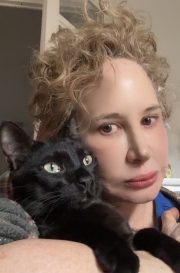THE INDIE FILES: I’m Selling Books, but Am I Making Money?
by William C. Tracy
Editor’s note: This is the first in a two-part series from William C. Tracy. Part 1 will focus on publishing and release costs, comparing traditional and indie publishing. Part 2 will present marketing resources, including a Google Sheets template, to help authors calculate their book costs.
How much do you make from a book? Depending on the method of publication, answers will vary. With traditional publishing, you might get an advance, and then, depending on how the book sells, might wait awhile (even years) to see more money. If you don’t get an advance, as with a small press or self-publishing, you might receive royalties more continuously, but in smaller amounts.
You could also have an instant bestseller and rake in the money! But here, we’ll look at what happens to most authors. This is a long road of writing, publishing, and gradually gathering more fans who want to buy your books.
You get royalties for your books, but how much does it cost to make that sale? There are a lot of expenses associated with traditional and self-publishing. Even though you’re making money selling books, it may be hard to break even in net profit (earnings minus costs). In this article and the next, we’ll go over how to assess these different costs and account for them while planning for your next book launch.
Publishing and Release Costs
What does it cost to release a book? We’re (sadly) not accounting for the blood, sweat, and tears writing the thing. We’ll assume you’ve done all that. I’m mainly covering self-publishing expenses, though I’ll note if a cost is also associated with traditional publishing.
Here are some of the costs associated with putting out a book. You may not have all of these, but you’ll probably encounter a lot of them:
- Developmental and copy editing. This can run into the thousands of dollars for professional editors. You shouldn’t have to pay for this in traditional publishing. You can–if you want to polish your manuscript before submitting it to an agent.
- Formatting and layout costs. You can certainly do this yourself. You might also hire someone for a couple hundred dollars or less.
- Cover and art costs. This one is incredibly variable. On the cheap, you can find a decent cover for $50. On the other end, if you have illustrations, a cover designer, and custom art, this could also be thousands of dollars.
- ISBN: if you want to publish a paperback book in the US that is not restricted to Amazon (or another single marketplace), you’ll need to buy an ISBN. There’s only one place to do that, at https://www.myidentifiers.com/. One ISBN will run over $100, while packs of tens or hundreds might get down to $5 per ISBN. How many books are you publishing? If you know you’re going to publish 5-10 books, the 10-pack might be a good choice.
- Publishing platform: It’s free to set up an author profile on Amazon, as well as most other publishing sites. However, some sites charge for making changes. For example, IngramSpark, one of the largest US distributors and the best way to get your book into bookstores and libraries, recently dropped their $50 “setup” cost, but still charges a fee for adjustments after the first 60 days.
- Library of Congress and copyright: You don’t have to pursue either of these, formally, even for self-publishing, but if you want the most official record of your work, applying, sending a book to the Library of Congress, and registering a copyright will run you about $70-80 total with costs and shipping.
- Release week costs: Hey, you’re ready to make money! How do you release your book? At full price and hoping people see it? Or at a discount, so more people are likely to buy it, while you pay money for marketing promotions and ads? Promotional materials can range from $0 to hundreds of dollars and lead to the real calculation, which is covered in the next section. Even if you’re traditionally published, you’ll likely have to do some marketing on your own nowadays.
Here’s a very broad estimate for publishing costs:
- Trad publishing: $0 to $1000+
- Self-publishing: $150-$3000+
So who would ever choose to self-publish? Aren’t you instantly losing money? Not quite. Let’s look at the next part of the equation: making money.
1) Write a book, 2) Something, something…, 3) Profit!
At this point, you’re probably thinking it’s better to go for traditional publishing, so you don’t have to cover all those costs above. The answer is complicated but can affect which one you choose. For now, assume you have a book out (hopefully) selling and making money. Let’s compare how both options might work.
Percentages! How much of your money do you keep? Let’s say you sell your e-book at $5 and your paperback at $20. If you’re traditionally published, you’re probably only going to see 10 percent or less of each sale, after enough books sell to pay off your advance. The publisher still has to pay for all that stuff you didn’t. That means you’re going to see maybe $0.50 per e-book and $2 per paperback. Until it’s paid back, this is reflected in the advance you received.
If you’re self-published, you’ll see a lot more money within about 2-3 months after publishing. There are a lot of details, but basically, you’re going to see somewhere from 30–70 percent of the book profit, minus any publishing costs. That means you might see $2–$3.50 on each e-book and $2–$8 on each paperback (there’s a lot of math behind the scenes).
A little quick calculating: if you sell 100 e-books and 100 paperbacks at full price, then you get (based on above estimates):
- Trad pub: $250. How much of the advance you received does this cover? You won’t get any more until that’s fully paid back to the publisher.
- Self-pub: $400–$1,150 delivered within about 3 months. How far does that go to pay back the publishing costs?
But we still haven’t answered the first question: are you making money? Next month, we’ll have more information on that part of the equation, plus a worksheet to make this easy for you to calculate.
For now, consider both options above. Knowing some of the costs associated with publishing a book will give you clarity on whether to pursue traditional publishing, self-publishing, or a hybrid. Self-publishing may take more capital at the start but may also pay back quicker. Traditional publishing can take much longer, but may give more immediate financial security. The decision will be different for each author.
 William C. Tracy writes and publishes queer science fiction and fantasy through his indie press Space Wizard Science Fantasy (spacewizardsciencefantasy.com). His largest work is the “Dissolutionverse,” a space opera with music-based magic, including ten books and an RPG. He also has a standalone epic fantasy with seasonal fruit-based magic, a nonfiction book about body mechanics and correct posture, and a hard sci-fi trilogy with generational colony ships and a planet covered by a sentient fungal entity.
William C. Tracy writes and publishes queer science fiction and fantasy through his indie press Space Wizard Science Fantasy (spacewizardsciencefantasy.com). His largest work is the “Dissolutionverse,” a space opera with music-based magic, including ten books and an RPG. He also has a standalone epic fantasy with seasonal fruit-based magic, a nonfiction book about body mechanics and correct posture, and a hard sci-fi trilogy with generational colony ships and a planet covered by a sentient fungal entity.
William is a North Carolina native and a lifelong fan of science fiction and fantasy. He has a master’s in mechanical engineering and has both designed and operated heavy construction machinery. He’s worked as a data analyst and in cost/benefit analysis for almost twenty years, which is where his love of spreadsheets comes from. He has also trained in Wado-Ryu karate since 2003 and runs his own dojo. He is an avid video and board gamer, a beekeeper, a reader, and of course, a writer.
You can get a free “Dissolutionverse” novelette by signing up for William’s mailing list at https://www.spacewizardsciencefantasy.com or follow him on BlueSky @wctracy.bsky.social, @wctracy@wandering.shop on Mastodon, and @wctracy on Twitter for writing updates, cat and bee pictures, and thoughts on martial arts.



